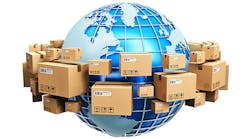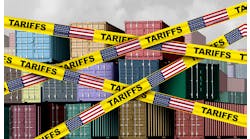The ongoing rebound of the U.S. economy has given way to a period of rapid change within the third-party logistics (3PL) sector. Arguably more diversified and sophisticated than ever, the 3PL sector is seeing an emergence in more 4PL partnerships, resulting in deeper, more strategic relationships.
This shift comes as a result of the challenges 3PL organizations are currently facing in the marketplace—from greater reliance on just-in-time inventory and the increasing role and reliance on technology, to congestion at the ports and the truck driver shortage. In response to these challenges, 3PLs have found themselves needing to streamline their organizations to ensure customer supply chains operate efficiently and seamlessly—and so that they maintain a competitive edge in the marketplace.
Collaboration has led to the consolidation of the supply chain, resulting in more agility, visibility and flexibility throughout a product’s lifecycle. Today’s 3PLs must be able to work with other partners and vendors in the supply chain to provide real-time data, forecasts and key performance indicators (KPIs) to react promptly to issues. Technology has become as important as cost when it comes to the selection of supply chain partners, and 3PLs that are not continually making investments into their technology infrastructure are finding they are lagging behind. 3PLs must have the ability to leverage technology to accommodate additional transactional volume at greater speed. The rate of change is exponential.
E-commerce now comprises 15% of all retail sales, driving smaller order quantities and more logistics around last-mile delivery. As a result, operational excellence is no longer a differentiator, but a requirement. The standards for supply chain partners continue to increase.
Additionally, we have seen an elimination of inventory builds and holds as shippers and manufacturers have moved toward just-in-time inventory, under the premise that it’s more economical to run larger production cycles based on customer buying habits rather than holding onto inventory for long periods of time at the warehouse level. Further, warehouse space in dense markets is tight, driven by Big Box retailer growth. This is especially true in port-centric areas like New York/New Jersey and Los Angeles/Long Beach. This creates extra headaches for 3PLs and shippers alike, as they try to anticipate space needs and contend with the associated costs.
With an increase in the number of transactions taking place on a daily basis, more requirements are being placed on the supply chain. Additionally, driven by an increased reliance on technology, there’s more of a need than ever for data and visibility throughout the supply chain. This is compounded by the fact that across the logistics industry, most organizations are not “on the same page” so to speak when it comes to technology and infrastructure.
For example, some shipping companies may not have the technology infrastructure in place to track products as they move through the supply chain. Or, they may have the technology, but their trucking company may not, so visibility is eliminated once the trucking company steps in to play its part. This can create extra headaches when the products in question are temperature-controlled, and maintaining and ensuring quality once they reach their end-user is paramount.
Because supply chain is demanding its partners be a one-stop solution to positively influence speed-to-market, shippers should consider partnering with a 3PL to maintain efficiency and achieve economies of scale. By partnering with a 3PL, shippers can mitigate many of these challenges and risks, and make their supply chains operate more efficiently and seamlessly. Working with a 3PL allows shippers to eliminate, consolidate and collaborate on data points and service providers, which helps to both simplify the process and achieve lower costs via economies of scale. Simply put, an average shipper cannot achieve the economies of scale that a 3PL can attain.
Not all 3PLs are created equal, however, and it’s important shippers identify the “right” partner in order to forecast, plan, collaborate, communicate and test with a view toward maximum flexibility. First and foremost, it is important 3PLs have in place a strong system for vendor and supply chain partner accountability that includes KPIs and incentives and rewards. This is important as the product moves throughout the supply chain, touching different vendors and processes as it passes.
Visibility is also a key factor in supply chain optimization, as today’s shippers and manufacturers want—and need—a clear window into the process with the ability to track their containers in real-time. As a result, 3PLs must have an innovative view of technology that includes the right infrastructure in place today, with an opportunistic view of the future.
Because supply chain requirements are continually evolving and changing, 3PLs should have adequate capital in place to ensure they can meet and exceed these conditions. Further, 3PLs should have a strong desire to continuously improve all facets of their organization—from their warehouse space to their technology to their transportation systems and networks. Strategic 3PL partners should have a value-oriented view versus a cost view, and should place importance on their customer relationships with an eye toward growth.
As with anything else, location is everything and those who are strategically situated near high-volume ports are generally able to offer additional value-adds and economies of scale as a result of their position and proximity to ports, steamship lines, rail terminals and highways. Size, critical mass and state of facilities are also characteristics to pay attention to. Additionally, shipping food-grade products and certifications in regards to cleanliness are important metrics to consider.
Finally, demonstrated experience and consistent long-term strategic goals should be discussed. Shippers want a partner that’s established in the marketplace, with solid industry relationships, a proven track record and an appetite for continued growth. 3PLs that continuously maintain a leadership position in the field are the ones who can provide the most from a strategic relationship standpoint, working to achieve efficiencies, economies of scale, and provide flexibility for growth.
There’s no shortage of challenges to overcome in today’s marketplace. However, with these challenges come many opportunities for improvement, growth, optimization and operational efficiencies. By partnering with a 3PL, shippers can not only overcome these challenges, but can also achieve economies of scale and efficiencies that would otherwise be unattainable. The result is an efficient supply chain that operates seamlessly, and helps shippers establish and maintain the competitive edge needed for long-term growth.
Jamie Overley is CEO of East Coast Warehouse & Distribution Corp., a provider of integrated temperature-controlled logistics services to food and beverage importers.



